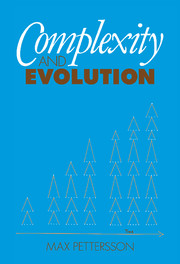Book contents
- Frontmatter
- Contents
- Foreword by Joseph Needham, FRS
- Preface
- Acknowledgements
- 1 Natural and other hierarchies
- 2 Major integrative levels
- 3 Some logarithmic forms of display
- 4 Physical range of integrated natural entities
- 5 Biological range of integrated natural entities (first part)
- 6 Biological range of integrated natural entities (second part)
- 7 Social range of integrated natural entities
- 8 Human societies (first part)
- 9 Human societies (second part)
- 10 Acceleration in evolution
- 11 Further allied accelerations
- 12 Aspects of number
- 13 Aspects of mass
- 14 Positive skewness
- 15 Quantitative conclusions
- Bibliography
- Index
6 - Biological range of integrated natural entities (second part)
Published online by Cambridge University Press: 18 January 2010
- Frontmatter
- Contents
- Foreword by Joseph Needham, FRS
- Preface
- Acknowledgements
- 1 Natural and other hierarchies
- 2 Major integrative levels
- 3 Some logarithmic forms of display
- 4 Physical range of integrated natural entities
- 5 Biological range of integrated natural entities (first part)
- 6 Biological range of integrated natural entities (second part)
- 7 Social range of integrated natural entities
- 8 Human societies (first part)
- 9 Human societies (second part)
- 10 Acceleration in evolution
- 11 Further allied accelerations
- 12 Aspects of number
- 13 Aspects of mass
- 14 Positive skewness
- 15 Quantitative conclusions
- Bibliography
- Index
Summary
Levels 6, 5 and 4
It will now be clear that a chromosome is a pre-eminent biochemical head-quarters, which initiates the making of many special protein molecules. A biological nucleus, containing a number of chromosomes, is a higher-level biochemical headquarters; and a multicellular organism is a biological system at an even higher level.
We may briefly check that the two criteria of Chapter 2, the compositional and the duality criteria, are satisfied. Certainly each intermediate entity, at Level 4, is composed mainly of molecules which are themselves members of Level 3. Each ordinary cell, of Level 5, is composed mainly of intermediate entities of Level 4, and each multicellular organism at Level 6 is also composed (materially) mainly of Level 5 cells.
Some bacterial cells, those with a single chromosome, are themselves intermediate entities which live freely and independently. While many other intermediate entities collaborate in the constitution of ordinary cells. Some ordinary cells, such as amoeba and Chlamydomonas (Fig. 2.1) live independently, while many other cells collaborate in the constitution of multicellular organisms. And while most multicellular organisms live independently, during the past 200 million years the mammals, birds and some insects have come to live in social family groups, where the adult actively aids the young after hatching or birth. Thus all three of the biological levels can be seen to satisfy both the compositional and the duality criteria.
Bacterial cells
The cells of bacteria (in the narrow sense) are spherical or rod-shaped, and from less than a micrometre to several micrometres in size (Fig. 3.1).
- Type
- Chapter
- Information
- Complexity and Evolution , pp. 53 - 60Publisher: Cambridge University PressPrint publication year: 1996



